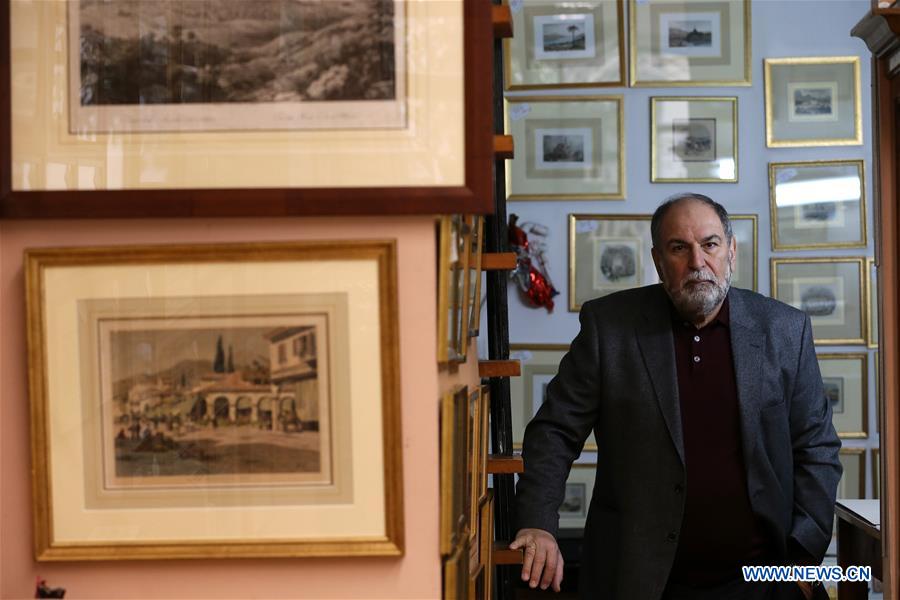
Photo taken on Feb. 22, 2019 shows Takis Kamarinos, owner of a store near Syntagma square, specializing in authentic gravures over the past 30 years, in Athens, Greece. A decade after the start of the Greek debt crisis, dealers of antique artworks, selling a piece of history, are welcoming the first signs of recovery, hoping for better days to come, they told Xinhua in recent interviews. (Xinhua/Marios Lolos)
by Maria Spiliopoulou, Valentini Anagnostopoulou
ATHENS, Feb. 26 (Xinhua) -- A decade after the start of the Greek debt crisis, dealers of antique artworks, selling a piece of history, are welcoming the first signs of recovery, hoping for better days to come, they told Xinhua in recent interviews.
As all sectors of Greek economy which shrank by 25 percent in the years of the crisis, antiquarian bookshops and galleries have been battered by recession and austerity, seeing their turnover plunging.
As the country has exited the harsh bailout period since last summer, they see light on the horizon, Takis Kamarinos, owner of a store near Syntagma square, specializing in authentic gravures over the past 30 years, told Xinhua.
Even though gravures, also known as prints or engravings, are considered a most affordable art object for the masses compared to paintings, Kamarinos and his colleagues still saw their clientele and revenues shrinking.
"Gravures'sales have increased a lot in recent years. There was a sharp decline during the first period of the crisis, but recovery has started," he said.
"Turnover deceased by 45-50 percent in the first years of the deeper crisis, let's say. Currently it is on the mend, it has gradually started to grow. It has not reached the pre-crisis levels of the golden years, as we used to say, but in any case it is better. There is light at the end of the tunnel. It is there," he added.
Despite the difficulties during the crisis, Kamarinos never lost his faith in the resilience of art.
"Art works always have a value in any era," he commented, pointing around to the treasures of his collection of old prints, maps and rare books, mainly of historical and travel content.
Prices are ranging from just 10 euros (11.4 U.S. dollars) to several thousands.
Kamarinos focuses on gravures reflecting the rich history of Greece. Until the dawn of the era of photography, engraving was the key method of producing images on paper in mapmaking, artistic printmaking or illustrations for books and magazines, he explained.
His collection includes Greek and foreign landscapes, maps, portraits, birds, flowers, marine topics, etc. He is particularly proud of a 1597 map of Greece by Ortelius Abraham, one of his oldest acquisitions from book fairs and auctions in Greece and abroad.
Through gravures depicting a view of the Acropolis hill in the 19th century or the Gate of Mesogeia which once stood in front of the parliament, where today are the stairs of the Syntagma metro station, he invites his visitors to take a trip to the past.
His clients are collectors, and art lovers, Greeks and foreigners, who are looking for a special gift or a souvenir. In recent years, the increase of tourism has helped Kamarinos and other dealers cope with the crisis. "The percentage (of customers) in the tourism season is big. It reaches 50-60 percent," he explained.
In the nearby affluent district of Kolonaki, Petros Vergos, owner of an auctions house, who has served as president of the Greek Union of Antiques and Art works Traders and is in the artworks trade business for 45 years, is also counting blows, losses, but sees the future with optimism.
"One in two of the old traders who were in the market 10 years ago, have closed down," he told Xinhua.
For two decades before the outbreak of the crisis, the Greek market of works of art witnessed spectacular rise, as all sectors of the economy, he said. The year of 2010 started the collapse. In the past two years it stabilized and now quality objects are sold in slightly improved prices, he noted.
Classical art objects, such as 19th century paintings, were mostly affected by the crisis. Prices plunged to 20 percent of the initial price, as wealthy households were forced to sell en masse family treasures, including fine Chinese porcelain, to pay off debts to the tax office or banks, Vergos told Xinhua.
Modern artworks which are closer to the taste of younger generations looking to invest in art, were more resilient. In this category the decline was about half of the initial price on average. Prices of such modern art works have stabilized and are on the rise, he noted. (1 euro= 1.14 U.S. dollars)











